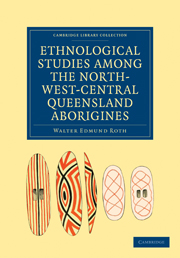Book contents
- Frontmatter
- PREFACE
- BIBLIOGRAPHY
- Contents
- ILLUSTRATIONS
- CHAPTER I THE SPOKEN LANGUAGE OF THE PITTA-PITTA ABORIGINALS: AN ELEMENTARY GRAMMAR
- CHAPTER II TABULAR COMPARISON BETWEEN VARIOUS SELECTED WORDS USED IN THE DIFFERENT ETHNOGRAPHICAL DISTRICTS OF NORTH-WEST-CENTRAL QUEENSLAND
- CHAPTER III SOCIAL AND INDIVIDUAL NOMENCLATURE: CLASS SYSTEMS, &c
- CHAPTER IV THE EXPRESSION OF IDEAS BY MANUAL SIGNS: A SIGN LANGUAGE
- CHAPTER V THE SEARCH FOR FOOD. PITURI
- CHAPTER VI DOMESTIC IMPLEMENTS AND UTENSILS. FIRE-STICKS AND YAM-STICKS. HUTS AND SHELTERS
- CHAPTER VII PERSONAL ORNAMENTATION AND DECORATION. MURAL PAINTING, &C.
- CHAPTER VIII RECREATION: CORROBBOREES, SPORTS, AND GAMES
- CHAPTER IX TRAVEL, TRADE, AND BARTER. THE SO-CALLED LETTER OR MESSAGE-STICK
- CHAPTER X THE MAINTENANCE OF LAW AND ORDER: FIGHTING, FIGHTING WEAPONS
- CHAPTER XI DISEASE, ACCIDENT, DEATH. CANNIBALISM
- CHAPTER XII RAIN-MAKING, THUNDER AND LIGHTNING-MAKING
- CHAPTER XIII ETHNO-PORNOGRAPHY
- INDEX AND GLOSSARY
- Plate section
CHAPTER I - THE SPOKEN LANGUAGE OF THE PITTA-PITTA ABORIGINALS: AN ELEMENTARY GRAMMAR
Published online by Cambridge University Press: 29 August 2010
- Frontmatter
- PREFACE
- BIBLIOGRAPHY
- Contents
- ILLUSTRATIONS
- CHAPTER I THE SPOKEN LANGUAGE OF THE PITTA-PITTA ABORIGINALS: AN ELEMENTARY GRAMMAR
- CHAPTER II TABULAR COMPARISON BETWEEN VARIOUS SELECTED WORDS USED IN THE DIFFERENT ETHNOGRAPHICAL DISTRICTS OF NORTH-WEST-CENTRAL QUEENSLAND
- CHAPTER III SOCIAL AND INDIVIDUAL NOMENCLATURE: CLASS SYSTEMS, &c
- CHAPTER IV THE EXPRESSION OF IDEAS BY MANUAL SIGNS: A SIGN LANGUAGE
- CHAPTER V THE SEARCH FOR FOOD. PITURI
- CHAPTER VI DOMESTIC IMPLEMENTS AND UTENSILS. FIRE-STICKS AND YAM-STICKS. HUTS AND SHELTERS
- CHAPTER VII PERSONAL ORNAMENTATION AND DECORATION. MURAL PAINTING, &C.
- CHAPTER VIII RECREATION: CORROBBOREES, SPORTS, AND GAMES
- CHAPTER IX TRAVEL, TRADE, AND BARTER. THE SO-CALLED LETTER OR MESSAGE-STICK
- CHAPTER X THE MAINTENANCE OF LAW AND ORDER: FIGHTING, FIGHTING WEAPONS
- CHAPTER XI DISEASE, ACCIDENT, DEATH. CANNIBALISM
- CHAPTER XII RAIN-MAKING, THUNDER AND LIGHTNING-MAKING
- CHAPTER XIII ETHNO-PORNOGRAPHY
- INDEX AND GLOSSARY
- Plate section
Summary
1. The Pitta-Pitta language is spoken mainly at Boulia, the chief encampment of the Pitta-Pitta blacks, as well as throughout the surrounding neighbourhood wherever any of their members may be scattered. It bears intimate relationship, as will subsequently be shown, to several other languages in close proximity, and ought rather to be considered in the light of one particular dialect out of many which together constitute the language of the Boulia district. Though the exact ethnographical limits of such a district must necessarily prove a matter of some difficulty, there is nevertheless a certain portion of country known to the Pitta-Pitta aboriginals as the “ooroo-ena mie-ena”—i.e., “one-and-the-same country”—throughout which the various dialects spoken by the different tribes are pretty similar, and more or less mutually intelligible.
2. For present purposes, therefore, the Boulia District will be understood as comprising the area bounded:—On the north by Buckingham Downs, Mount Merlin, and Chatsworth; on the east by Tooleybuck country and Springvale; on the south by Cluny, Bedouri, and Sandringham; on the west by Carlo (vel Mungerebar) and Glenormiston (vel Idamea) country. In other words, it includes the district drained by the Hamilton, Burke, Wills, King's Creek, Upper Mulligan, Cottonbush Creek, and Middle Georgina Rivers, and measures approximately about 10,000 square miles.
3. The following Spelling, upon an English basis, has been adopted throughout the text.
- Type
- Chapter
- Information
- Publisher: Cambridge University PressPrint publication year: 2010First published in: 1897



